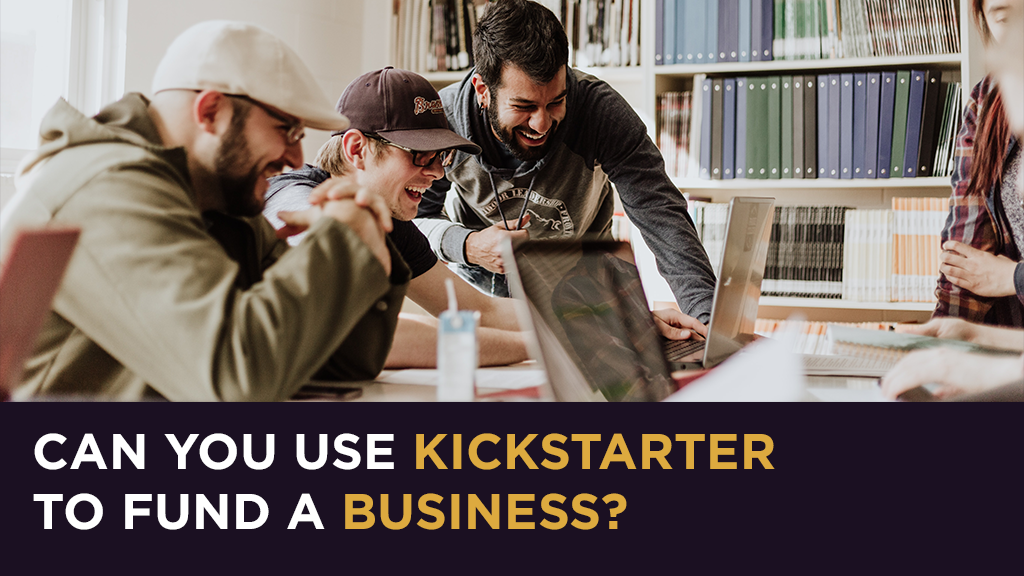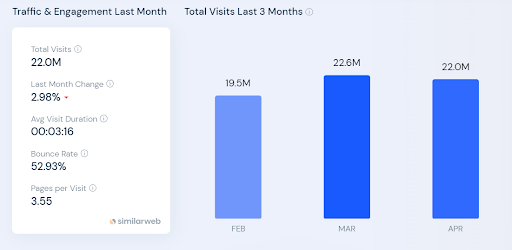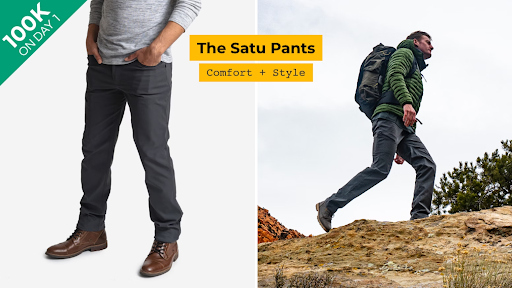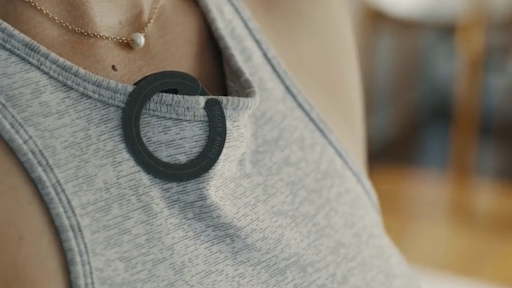
We’re in an era where access to traditional financing can be challenging, particularly if you don’t have a favorable credit score. So, alternative avenues become vital to fueling business growth.
The conventional barriers to entry, such as stringent loan requirements or the need for extensive personal savings, often hinder the dreams of budding business owners.
However, Kickstarter presents a refreshing departure from the norm. If you have a captivating idea and a compelling story, you have the power to captivate a global audience.
So, can Kickstarter truly provide enough funding for you to launch or propel your business forward?
Contents
- Key takeaways
- Can you fund a business through Kickstarter?
- Is Kickstarter a good way to start a business?
- What are the benefits of using Kickstarter to fund a business?
- What are the downsides to using Kickstarter to fund a business?
- Kickstarter vs. Indiegogo vs. GoFundMe, how do they compare?
- Examples of successful Kickstarter campaigns for business
- Can you extend a Kickstarter campaign if your funding is not met?
- Final thoughts
Key takeaways
- Kickstarter can be an excellent way to fund your business
- Kickstarter offers access to a large audience of potential backers
- Kickstarter, Indiegogo, and GoFundMe are popular crowdfunding platforms for funding business ventures
- Kickstarter operates on an all-or-nothing funding model, while Indiegogo offers both fixed and flexible funding options
- Consider the funding model that aligns with your campaign objectives and risk tolerance
- Many successful campaigns have a unique value proposition
Can you fund a business through Kickstarter?
Yes, you can fund a business through Kickstarter. A successful Kickstarter campaign will provide enough funding to take your idea or business to the next level.
How does this process work?
Kickstarter provides a platform to showcase your ideas and connect with potential backers.
You then present a compelling campaign to a community of supporters who are passionate about innovative projects. These backers then provide the necessary funds to bring your idea to life or propel your existing business forward in exchange for a reward.
However, there are a few things you need to know before you get started with Kickstarter:
All-or-Nothing funding model
Kickstarter uses a funding model called all-or-nothing. This means that you won’t receive any pledged funds if your campaign doesn’t reach its funding goal within the specified timeframe.
This approach is designed to assure backers that projects will be fully funded before proceeding.
Fierce competition
Kickstarter platform has a global reach and popularity. This means that countless projects are vying for attention and funding.
As of August 2023, there were 601,300 campaigns launched on Kickstarter and 244,312 successfully funded projects.
This means that your campaign needs to stand out from the crowd to attract backers.
But don’t let this discourage you, at LaunchBoom many of our clients have either reached or exceeded their funding goals within the first day. So if you’re unsure about where to begin with crowdfunding, we can help!
Maximum reward tier
Kickstarter limits the maximum value for a single reward tier. This ensures fairness and prevents excessive amounts from being pledged for a single reward. Luckily the reward tier values are quite substantial.
See this summary table for the maximum amount you can set as a reward tier value (this depends on your project location):
| REGION | MAXIMUM AMOUNT |
| US-based project | $10,000 |
| UK-based projects | £8,000 |
| Canada-based projects | $13,000 CAD |
| Australia-based projects | $13,000 AUD |
See the exhaustive list here.
Is Kickstarter a good way to start a business?
Kickstarter can be an excellent way to fund your business. But it’s important to approach it with realistic expectations and careful planning. Especially if you’re just starting out.
To know if Kickstarter is a suitable avenue for starting your business, consider the following:
Type of business
Kickstarter is well-suited for certain types of business, like product-based businesses, creative projects, and niche or enthusiasts markets. One of its top categories has been tabletop games and board games. It’s important to note that Kickstarter requires a prototype and doesn’t allow you to rely on concept drawings to promote your campaign.
Service-based businesses or those that require significant infrastructure or ongoing operational expenses may find it more challenging to leverage Kickstarter as a primary funding source.
Product validation
While Kickstarter has seen numerous successful projects, the platform has also witnessed its fair share of projects that have failed to secure the desired funding.
According to Statista,
“The total number of unsuccessfully funded projects on the U.S. crowdfunding platform Kickstarter amounted to 349,814 up to May 2023. The number of projects that were 0 percent funded was 56,220 up to this point.”
Many campaigns fail because they fail to set their product up for success before launch by establishing a value proposition and validating their product. So, set realistic expectations when setting your funding goals on Kickstarter. If you’re not sure how to validate your product, we can help with our guide to product validation.
Additional funding sources
Does your business require additional funds after the campaign? Will the Kickstarter funding be sufficient to cover all your expenses?
If not, ensure you have access to other funding sources, such as personal savings, loans, grants, or investments, or adjust your funding goals and strategies accordingly.
What are the benefits of using Kickstarter to fund a business?
Kickstarter is one of the most successful crowdfunding platforms in the world with $7,499,425,346 pledged as of August 2023 and an audience of more than 22 million backers. So if you’ve decided to crowdfund your idea, Kickstarter would be the ideal place to start.
Let’s look at some of the benefits of using Kickstarter
Access to a large audience
Kickstarter has a substantial user base of potential backers who actively seek out innovative and exciting projects to support.
For example, according to Similarweb in April 2023, Kickstarter.com had 22 million visits.

This significant user base is always on the lookout for new products, after all that’s why they use the platform. It’s just a matter of identifying the right niche and capturing that audience.
Additionally, the diverse nature of the Kickstarter community means that you can connect with people from various backgrounds, industries, and locations who are looking for all kinds of products.
For example, Kickstarter audiences are interested in things like:
- Games
- Crafts
- Fashion
- Food
- And more
-
Opportunity to gauge market interest
Backers on Kickstarter are inherently early adopters and enthusiasts.
Their engagement and response to your campaign can be a powerful indicator of the market’s interest in your business.
If your campaign attracts many backers and successfully reaches its funding goal, you know there is a market demand for your product or business concept.
If your campaign fails or struggles to attract backers, then there’s limited market interest, or adjustments need to be made to your business strategy. It can also mean that your campaign strategies need to be reworked.
Ability to raise capital without giving up equity
Unlike traditional funding methods, like venture capital or angel investment, Kickstarter operates on a rewards-based crowdfunding model.
You offer various rewards or incentives to backers who support your campaign financially.
These rewards include:
- Early access to your product
- Exclusive merchandise
- Unique experiences related to your business
This approach lets you retain full control and ownership of your business while still securing the necessary capital to bring your idea to life or scale your operations.
You don’t have to negotiate terms with investors or give up a portion of your profits or decision-making power.
NOTE: Raising capital without giving up equity comes with the responsibility of fulfilling the promised rewards to your backers. So carefully plan and budget for the production, fulfillment, and delivery of these rewards to ensure a satisfactory experience for your backers.
Opportunity to generate buzz and publicity
A Kickstarter campaign allows you to create a compelling narrative around your business idea or product.
You showcase your unique value proposition, highlight the innovation behind your project, and effectively communicate your story to potential backers through videos and images.
This storytelling aspect helps to captivate and engage the audience, creating a sense of anticipation and generating buzz around your business.
If your campaign succeeds, it could attract attention from media outlets, blogs, influencers, and other industry stakeholders.
Journalists and bloggers are always looking for interesting projects and success stories to cover. This provides an opportunity for your business to gain valuable exposure and publicity.
Sometimes this exposure extends beyond the Kickstarter community. This helps you to connect with a wider audience and potentially attract the interest of investors, partners, or customers.
What are the downsides to using Kickstarter to fund a business?
It’s always good to look at both sides of the coin and keep in mind that Kickstarter has its downsides and challenges. Here are some of the unique drawbacks:
All-or-Nothing funding model
You won’t receive any funds if you don’t reach your predetermined funding goal by the campaign deadline.
Remember, it takes money to plan the campaign, to advertise (Facebook Ads), and pay your team. So, you could be left with losses if you don’t reach your goal.
Kickstarter campaigns require careful planning and effective marketing strategies to ensure your campaign gains enough traction to meet or exceed the funding goal.
Even then, your campaign may only be enough to get your business started. There’s still a whole lot of work to be done post-campaign to keep your business successful.
Time and resource intensive
Planning and launching the campaign, creating compelling content, engaging with backers, and fulfilling rewards are demanding and time-consuming.
It could require a dedicated team to manage the campaign effectively.
This can divert attention and resources from other crucial aspects of your business, such as product development or day-to-day operations.
Limited post-campaign support
Once your Kickstarter campaign concludes, the platform’s involvement in supporting your business diminishes.
Post-campaign support is primarily your responsibility.
In this guide, we show you how to fund your campaign post-crowdfunding.
Lack of investor participation
Investors could be good for more than just funding. They challenge your assumptions, provide strategic guidance, and contribute to the long-term success of your business.
On Kickstarter, the level of participation is relatively limited. Backers are primarily motivated by their interest in the project and its associated rewards. They are not looking to actively participate in the business’s growth and decision-making processes
Kickstarter vs. Indiegogo vs. GoFundMe, how do they compare?
Kickstarter, Indiegogo, and GoFundMe are the most popular choices for crowdfunding. Each platform has its unique features and target audience.
Here’s a summary table of the differences between these platforms:
| Platform | Funding Model | Target Audience | Project Categories | Key Features |
| Kickstarter | All-or-nothing | Creative projects | Arts, technology, design | Large user base, strict guidelines |
| Indiegogo | Flexible and Fixed funding | Diverse range of projects | Technology, arts, causes | Global reach, flexible funding options |
| GoFundMe | Donation-based | Personal and social causes | Medical, emergencies | Easy setup, social sharing |
Kickstarter vs. Indiegogo for business
Kickstarter and Indiegogo are the two biggest options for crowdfunding platforms for businesses. The two biggest differences between these two are their size, Kickstarter is a larger platform, and their funding models.
As you already know, Kickstarter operates on an all-or-nothing funding model, meaning you must reach your funding goal within a specified timeframe to receive the funds. If your campaign is successful, Kickstarter takes a 5% platform fee. Additionally, payment processing fees ranging from 3% to 5% are charged by the payment service provider.
On the other hand, Indiegogo offers both fixed and flexible funding options. With the flexible funding option, you don’t have to reach your target goal to receive funds. You just collect whatever you’ve managed to raise.
Indiegogo charges a 5% platform fee on all funds raised, and their payment processor, Stripe, charges a processing fee of 3% plus $0.30 per transaction. However, if you choose the flexible funding option, you will pay the 5% platform fee even if you don’t reach your campaign goals.
When deciding between Kickstarter and Indiegogo for your business, consider the following:
- The funding model that aligns best with your campaign objectives
- The risk tolerance
- Evaluate the associated fees and payment processing costs
Kickstarter vs. GoFundMe for business
While GoFundMe is primarily known for personal and social causes, you can also utilize it to raise funds for specific business projects or initiatives.
Unlike in Kickstarter, on GoFundMe, you get to keep all the funds you raise, regardless of whether you reach your target or not.
On the fees, GoFundMe says, “There’s no fee to start or manage your fundraiser. However, to help us operate safely and securely, our payment processors deduct one small transaction fee per donation (2.9% + $0.30, which includes debit and credit charges).”
Consider the following when choosing between Kickstarter and GoFundMe:
- The project type – Kickstarter is good for creative and innovative projects. While GoFundMe is primarily for specific projects with a social impact, or community causes.
- Fee structure – Kickstarter charges a 5% platform fee for successfully funded campaigns. GoFundMe takes a transaction fee per donation (2.9% + $0.30).
Examples of successful Kickstarter campaigns for business
Let’s look at some successful projects to see the immense potential of Kickstarter.
Tidyboard

Backers: 5747
Average Pledge Per Backer: $107
Funded: $612,395 of $10,000
Dates: Jun 16th to Jul 16th (30 days)
Tidyboard introduced a unique and innovative solution to a common problem in the kitchen – reducing prep and clean-up time.
The product’s multifunctional design, combining a cutting board and waste disposal system, offered home cooks a practical and efficient solution.
What made the campaign a success?
This campaign effectively communicated the value proposition of Tidyboard. It highlighted the time-saving benefits, convenience, and improved organization it brings to the kitchen.
The campaign also presented Tidyboard in an engaging and visually appealing manner. They used high-quality images, demonstration videos, and clear explanations of the product’s features and benefits.
Further, the campaign effectively captured emotion by emphasizing the importance of healthy eating and the positive impact the product can have on people’s lives. By stating that “TidyBoard cares about healthy eating,” they tap into the emotional aspect of individuals wanting to make healthier choices in their diet.
Satu Adventure Pants

Backers: 3682
Average Pledge Per Backer: $181
Funded: $665,455 of $25,000
Dates: Apr 14th to May 21st (37 days)
The Satu Adventure Pants campaign by Outdoor Vitals was about raising funds for pants built to stand the mountains, look good in the city, and keep you ultra-comfortable through it all. The pants were designed to be comfortable and functional for outdoor activities and stylish enough to wear in the city.
What made the campaign a success?
The campaign effectively identified and targeted its intended audience—outdoor adventurers and individuals who value performance and style in their apparel choices.
By tailoring the messaging and visuals to resonate with this specific demographic, the campaign was able to capture their attention and generate interest.
Also, the commitment by Outdoor Vitals to donate 1% of their revenue to sustainable poverty projects around the world may have contributed to the campaign’s success.
By highlighting their commitment to positively impacting and addressing global poverty issues, Outdoor Vitals aligns their brand with a larger purpose beyond just selling products.
This resonates with socially conscious consumers who appreciate businesses that prioritize social and environmental responsibility.
Hooke Lav

Backers: 3461
Average Pledge Per Backer: $168
Funded: $580,753 of $10,000
Dates: Sep 22nd to Oct 22nd (30 days)
The Hooke Lav is a wearable microphone that captures professional-grade audio wirelessly from your smartphone. It’s designed to be easy to use and versatile, allowing you to record high-quality audio for videos, podcasts, live streaming, and more.
What made the campaign a success?
One of the main factors that made this campaign successful is how Hooke Lav was positioned in the market.
It was positioned as follows:
- The tiniest Bluetooth mic you can wear
- Capture audio anytime, anywhere
- Uncompromising sound quality
- The ultimate sound experience (4K of sound)
These unique features and capabilities helped generate interest and excitement among potential backers.
To further drive interest and engagement, the campaign implemented a Reservation Funnel strategy. Users could reserve Hooke Lav at a discounted price of $69, significantly below the anticipated retail price of $110.
This exclusive offer incentivized backers to secure their Hooke Lav units during the campaign, creating a sense of urgency and value for their contribution.
Can you extend a Kickstarter campaign if your funding is not met?
Yes, extending a Kickstarter campaign is possible if the funding goal is not met within the initial timeframe.
Kickstarter introduced this policy in March 2020. It allows for deadline extensions in certain circumstances, particularly in response to challenges posed by the COVID-19 pandemic.
However, the decision to grant an extension is at the discretion of the support team and is subject to specific criteria.
Also, note that extensions can only be granted during the final week of a campaign and can’t exceed the maximum funding limit of 60 days.
Final thoughts
Crowdfunding presents a unique opportunity to tap into a vast audience fueled by curiosity and a thirst for groundbreaking projects.
And in this realm, Kickstarter stands tall, connecting you to backers.
However, on Kickstarter, you’ll encounter fierce competition. This demands a unique positioning that sets your campaign apart from the rest.
If you need help with your crowdfunding campaign, talk to us at LaunchBoom.



